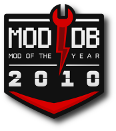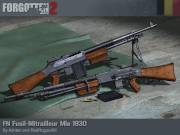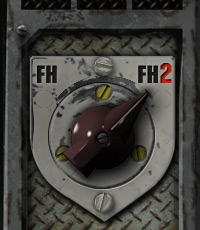 |
||
|
|
||
 |
||
|
Adapt, Improve, Adopt09.04.2023 18:30 GMT Hello and welcome back to another Forgotten Hope 2 update. Today we are showing off the primary light machinegun of the Belgians in May 1940, the Fusil-Mitrailleur Modèle 1930. The Belgian army prior to WW1 had some experience with light machine guns, notably the Hotchkiss Portative and the Madsen, which were in service with the cavalry. However, once both sides had entrenched themselves they were replaced with heavy machine guns. With renewed emphasis on offence in the second half of the war, the Belgian army regained interest in light machine guns and adopted the French Chauchat, which served them throughout the rest of the war. After the war Belgium obtained considerable quantities of German arms and ammunition as war reparations, including MG08/15 machine guns. Since this left the army with weapons in three different calibres, a modernisation program rechambered the MG08/15s to 7.65mm and upgraded the Chauchats to the Modèle 15-27 standard, featuring numerous dust covers, and a new 15-round magazine to go with the standard Belgian 7.65mm rifle round. This would only be a stopgap, with these guns obsolete by the end of the 20's. In 1919, FN acquired the licence to produce and sell commercial variants of the Browning Automatic Rifle. By 1921 FN was producing BARs for the Swedish military, where they would be known as the Kg m/21. Another military contract would follow later in the decade, this time for the gun that became the Polish RKM wz.1928. Apart from the military contracts, FN also became the exclusive vendor for the Colt R75 and Monitor variants. FN, with the help of gunsmith Dieudonné Saive, modified the R75 to feature a new gas valve and a mechanical fire rate reducer. The Fusil-Mitrailleur Modèle 1930 was born, and promptly adopted by the Belgian army. Production of the FM30 ran from 1930 to 1933, with 5,126 guns made. With the general mobilisation of 1939, production was restarted. All branches of the standing army, and part of the active reserve would eventually be equipped with the new guns. The second-line reserve would continue to use the Chauchat 15-27. Mostly used as an infantry weapon fired from the bipod, it was also pressed into the medium machine gun role from a tripod, and used as a light anti-aircraft gun. It could also be found mounted in the turrets of the T-13 tank destroyer. The FM30 was well liked by the troops, although they noted a tendency to overheat. This critique would eventually lead to the development of the 1932 FN-D (Démontable) with a quick-change barrel. A small number would also see service in the German army after the surrender as the 7,65 mm leMG 127(b). Ours was made by Ashton and RedRogueXIII. That's all for this week, but be sure to come back next time for another update. Until then, feel free to visit our Discord, our public forums, our Twitter, our subreddit, and/or Facebook pages to discuss this update and other news. |
|
||||
 |
||||||




























